Taken from the April 2021 issue of Physics World.
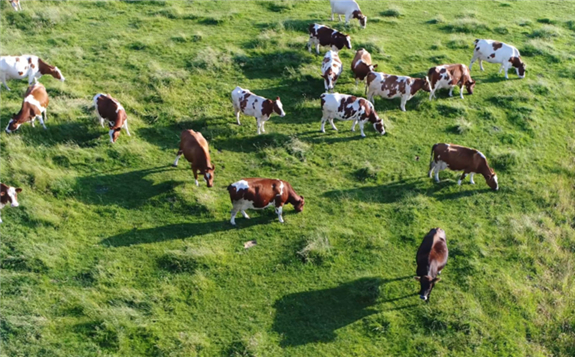
Cutting methane production from livestock is considered vital to climate change mitigation, with lots of research focusing on how animals breed and are fed. But physicists are playing their part too by developing ways to measure the emissions from cattle, using techniques such as spectroscopic analysis and aerial sampling, as Michael Allen discovers
A few years ago, atmospheric physicist Grant Allen and his colleagues were using drones to measure methane emissions from a fracking site in Lancashire in the north-west of England. But next door to the shale-gas operation was a dairy farm and the researchers wondered if they could also measure the methane produced by the cows. So while the animals were in the barn being milked, the researchers flew their drone system in the fields outside.
“They have about 150 cows and once you put them all inside a box, like a barn, they become a condensed system that you can model as a point source of emissions,” says Allen, who is based at the University of Manchester, UK. It is then possible to measure the concentration of the methane that is downwind with a drone. “And if you know the wind speed and you’ve got the measurement of the concentration,” Allen continues, “you can do some clever maths to calculate what the emission flux is in grams per second from the herd as a whole – that way you can get an average emission per cow.”
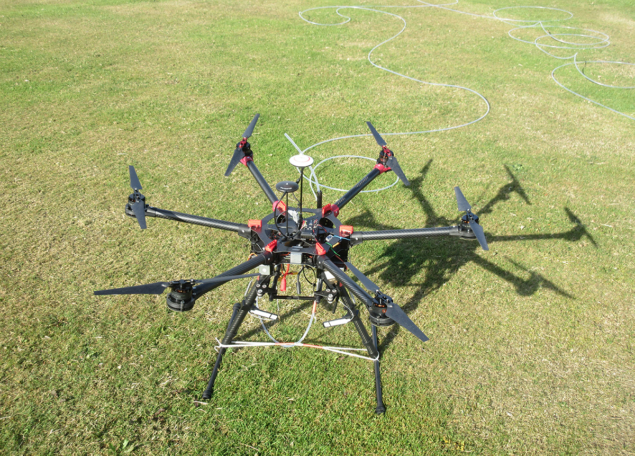
Cattle are responsible for a huge amount of greenhouse-gas emissions. Globally the livestock sector accounts for the equivalent of seven gigatonnes (7 × 1012 kg) of CO2 every year, according to the United Nations. This is around 15% of anthropogenic emissions – a similar proportion to cars. On a commodity basis, beef and milk from cows are responsible for the highest proportion of these emissions. And almost 40% of that seven gigatonnes is methane produced by fermentation in the stomachs of ruminants – mainly cows.
Over the course of a week, the fracking site that Allen and his colleagues were monitoring released more than 4 tonnes of methane – equivalent to the environmental impact of 142 trans-Atlantic flights. But this was linked to a single event, thanks to operations to clean out a 2.3 km-deep shale gas well. While sources of methane like this are sporadic, cattle belch methane all year round. “If you compare it over a few days, the fracking site was emitting a lot more per unit time over that period,” Allen explains. “But if there were no other emissions from the fracking site for the rest of the year, then the cumulative flux from a dairy herd of 150 cows for a whole year is more.”
Fermenting plants, burping methane
Cows and other ruminants eat grass, straw and other fibrous plants that are simply indigestible to most other animals. To extract nutrients from the complex carbohydrates – particularly cellulose – in these plants, the animals ferment them in a special stomach chamber known as a rumen. In this oxygen-free environment, microbes (mainly bacteria) break down the complex plant material. But as this process occurs, it produces a vast amount of hydrogen.
As the hydrogen builds up, the cow turns to another group of bacteria-like micro-organisms known as archaea. These bugs use the hydrogen as a source of energy but produce methane as a by-product, a process known as methanogenesis. And as this gas builds up, the cow belches it out, which is good for the cow, but not the planet because methane is a potent greenhouse gas. Although it only survives in the atmosphere for a decade or two, over a 20 year period it has more than 80 times the global-warming potential of carbon dioxide, according to the Intergovernmental Panel on Climate Change.
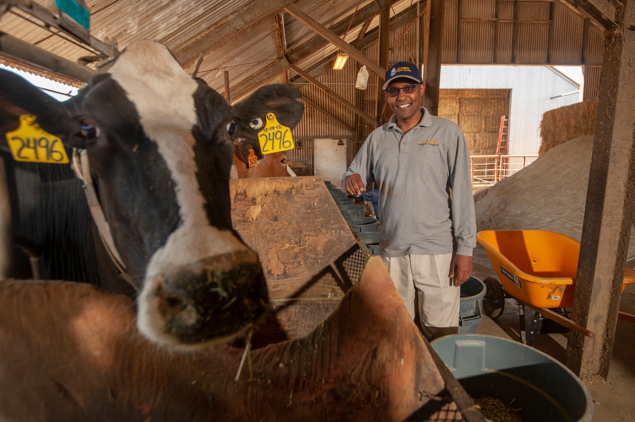
This makes methane a good short-term target for tackling climate change, says animal scientist Ermias Kebreab, director of the World Food Center at the University of California, Davis. While reducing carbon dioxide needs to be the long-term focus, it will take a while for us to see the effects of this as carbon dioxide persists in the atmosphere for centuries. “But the effect of slowing down or reducing methane will be felt in a decade or so,” explains Kebreab. And given that they are responsible for more than 40% of anthropogenic methane emissions, livestock are a good place to start.
Improving productivity is key to reducing emissions. According to Kebreab, you can make animals produce more protein – milk or meat – per kilogram of feed with a combination of genetics and good nutrition. For example, he explains, there are cows in low-income countries that produce around 4–5 kg of milk per day. But if you were to cross breed those with Holstein-Friesian cows – which are renowned for their high milk production – you could get 20 kg of milk per day, while maintaining some of the advantages of the local breeds. Indeed, over the last five decades, a focus on breeding and meeting nutritional requirements has cut methane emissions per litre of milk by about 50% in the US. There are now fewer dairy cows than half a century ago, but they each produce more milk (figure 1).
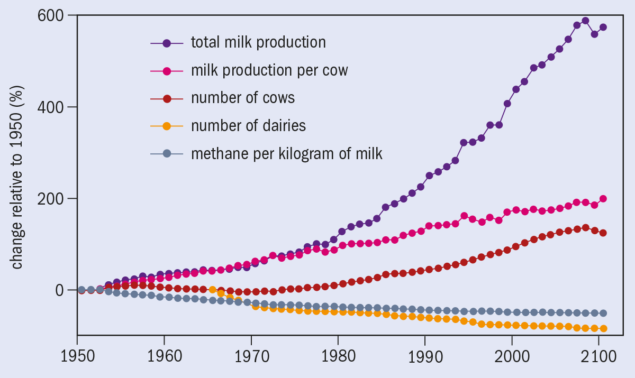
Seaweed supplement
To cut emissions even further, Kebreab’s recent work has focused on using seaweed as a feed additive. He and others have shown that adding various species of seaweed to a cow’s food can reduce methane production by as much as 90%. “It’s absolutely crazy,” Kebreab exclaims, adding that there is minimal processing of the seaweed before it is given to the cattle. “When it’s collected, we freeze dry it to make sure that the active ingredient is stable. After that, you just crush it into a powder, which is added to the feed,” he explains.
The seaweed inhibits methanogenesis. The archaea in the cows’ rumen use enzymes to break down gases, but various compounds in the seaweed appear to interfere with some of these enzymes. This means the microbes are unable to complete the process and much less methane is produced. Other compounds have also been found to have similar effects. The Swiss AgriTech company Mootral claims that its garlic-based additive shows a 40% reduction in methane production.
In his research, Kebreab measures the methane produced by the cows using a system called GreenFeed. This trough-like machine contains food to entice the cattle and then measures the gases they breath and burp out while they are eating. There are also other devices for measuring the emissions of individual animals, such as respiration chambers and hand-held spectroscopy devices. While these systems are accurate, using them to measure large numbers of animals is expensive and time consuming. To get around this, animal scientists use the measurements from small numbers of animals to create models of emissions from different feeding systems that can be applied to whole herds. Increasingly, however, people are exploring ways to measure whole herds. That makes sense, as the variability in emissions between one cow and another can be huge. Such large-scale measurements can also help confirm models based on emission measurements from individual animals.
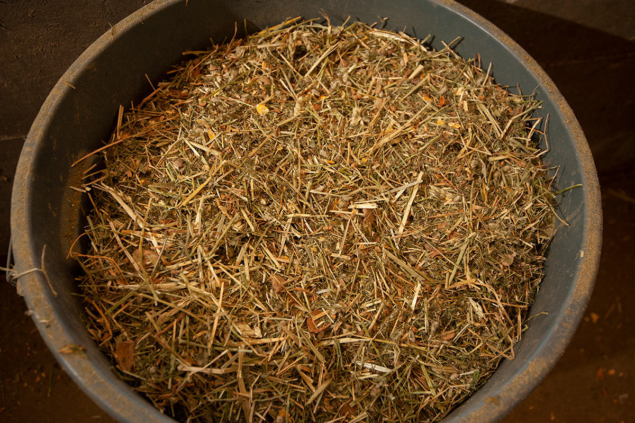
In the UK, Allen’s drones are tethered to the ground by a 150 m-long tube. As they fly downwind of the methane source, they pump air down through the tube to a spectrometer, which identifies different gases based on their spectral signatures (Atmos. Meas. Tech. 13 1467). “We’re essentially measuring on the ground, but we’re measuring air that’s been brought down from where the drone was at that time,” Allen explains.
To test their mathematical models and accurately measure methane fluxes, Allen and his team developed a method that involved the controlled release of methane from a cylinder in a field. To ensure there was no cheating, it was decided that the person who flew the drone, analysed the data and calculated the methane emissions was not aware of how much methane was in the box, or the rate at which it was released. The result was a good correlation between the measurements and the known methane release. But achieving accurate results requires multiple flights adding up to a few hours of flight time.
Whole herd, or individual cow
Phil Garnsworthy, head of animal sciences at the University of Nottingham in the UK, is researching breeding cattle that are genetically predisposed to produce less methane. He says that the microfauna of the rumen varies from one cow to another, and appears to be fixed by genetics. “You can take the rumen contents from one cow and put it into another and after about two to four weeks, the population of bugs will go back to what it was before,” he explains.
“The cow has control over her rumen microbes. Breeding for low methane is breeding for a particular population of microbes in the rumen.” While respiration chambers provide accurate data, they are impractical for large-scale measurements of methane emissions, says Garnsworthy. That’s because when measuring methane emissions for breeding purposes, the cows need to be confined in the chamber for about three to seven days to get decent figures.
In the Nottingham study, the dairy herd is milked by robot. The cows, which wear chips for identification purposes, each come in three times a day and feed while being milked. To provide long-term methane measurements from individual animals Garnsworthy and his colleagues decided to try installing gas analysers in the feeding trays – a tube near the animal’s nostrils connected to an infrared spectrometer. “The first cow stuck its head in, and we suddenly saw this massive peak in methane about once every minute,” Garnsworthy says, “and we thought that must be it breathing in and out. Then we realized that it breathes in and out more often than once a minute, and that it was belching methane.”
The measurements from this technique are comparable with respiration chambers, the researchers found (Animals 10.3390/ani9100837). Garnsworthy says there are sectors of the scientific community who think his technique is “rubbish”, arguing that it is not as accurate as techniques like respiration chambers. But he believes that these other methods are not measuring cows under normal commercial conditions.
“They say our technique is so variable that it is not accurate enough for individual cows, but what we can do is measure them thousands of times and then get a pretty precise average,” he explains. And as this method involves measuring all the animals, individual measurements can be combined to provide methane emissions for the whole herd. That’s good because researchers can then compare emissions from farms or herds without having to measure individual animals. But, as Garnsworthy cautions, if you are interested in comparing animals for breeding purposes or conducting nutritional experiments, the observational unit needs to be individual animals. “It just depends what you want the data for.”
Elsewhere, researchers have been looking at systems that can monitor herds for longer periods, or even continuously. One option is to use point source lasers that criss-cross the field to measure emissions from the herd. In 2014 Richard Todd and colleagues at the US Department of Agriculture used this spectroscopy technique as well as the GreenFeed breath analysis system to measure emissions from 50 cattle grazing 26 hectares of Oklahoma grasslands. Three lasers scanned 16 paths over the prairie, while the cattle were fitted with GPS collars to track their locations.
Weather conditions and data on the positions of the cows allowed the researchers to measure upwind and downwind gas concentrations to track methane emissions from the cattle. They found that the laser results of methane emissions were comparable to the GreenFeed system, concluding that the open path lasers tended to overestimate emissions, while the GreenFeed method tended to underestimate them.
Sensitive scanning
Other scientists are looking at even more sensitive techniques. In 2019 Daniel Herman of the National Institute of Standards and Technology (NIST) demonstrated that dual frequency combs can measure emissions from cattle herds (Conference on Lasers and Electro-Optics 10.1364/CLEO_AT.2020.AW4K.1). A frequency comb is a very precise spectroscopy instrument, in which lasers emit a continuous train of very brief, closely spaced pulses of light covering millions of different frequency peaks. The individual peaks look like the teeth of a comb – giving the tool its name. These laser pulses act as markers that allow the detector to measure the spectral signature of any material through which they have passed, with incredible precision. Dual frequency combs use two combs with slightly different tooth spacing. This creates an even more sensitive device that acts like hundreds of thousands of laser spectrometers working together.
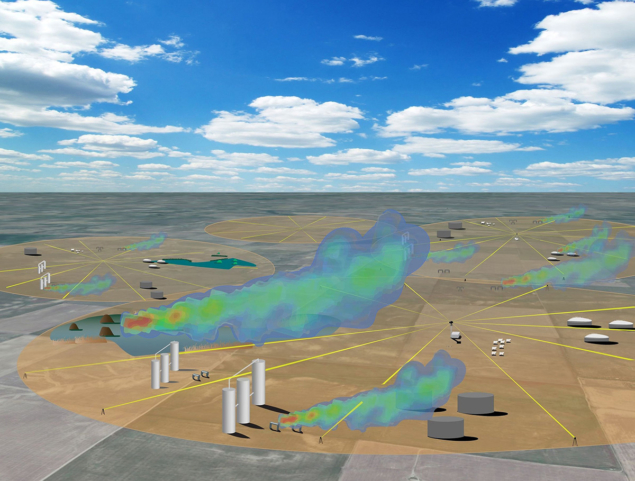
2 Detecting methane leaks Researchers led by Daniel Herman at the National Institute of Standards and Technology in the US have used a mobile dual-frequency comb laser spectrometer to measure bovine emissions. The spectrometer sits in the centre of a circle that is ringed with retroreflecting mirrors, with laser light from the spectrometer (yellow line) passing through a gas cloud and striking the retroreflector before being returned directly to its point of origin. The data are used to identify leaking trace gases (including methane), leak locations and emission rates. (Courtesy: Stephanie Sizemore and Ian Coddington / NIST)
In 2018 another NIST team, led by physicist Ian Coddington, had already demonstrated that a portable dual-frequency comb could be used to detect methane and other emissions outdoors, with extreme precision and over large areas (Optica 5 320). In field tests designed to simulate emissions from oil and gas production, Coddington’s team was able to measure methane emissions of 1.6 g per minute from a kilometre away (figure 2). Herman and colleagues used two dual frequency combs on opposite sides of a feedlot containing around 400 cattle. One comb was downwind of the pen and the other upwind, to measure gas concentrations as air flowed in and out of the pen. The downwind system detected increases in methane, carbon dioxide and ammonia.
According to Allen, there are advantages and disadvantages to both the fixed-lasers-based systems and drones. While the fixed systems can monitor emissions continuously, they often rely on the wind blowing in a certain direction, so there can be a lot of dead time with emissions being missed. Also, methane is buoyant and can rise quite rapidly. The ground-level lasers can miss these plumes, while the drones can cover that vertical dimension and be positioned to account for wind direction. However, drones are expensive; require someone to fly them; and can only monitor for short periods at a time.
It is, however, also possible to measure methane emissions using aircraft. This is what Ray Desjardins, an atmospheric scientist at Agriculture and Agri-Food Canada, has spent decades working on. He explains that every 20th of a second, the equipment onboard an aircraft measures the concentration of different gases in the air, as well as the vertical motion of the air. “Basically, if there is a difference in the concentration between the air going up and down you can easily calculate the emission of a gas,” he says. But aircraft-based measurements can struggle to measure specific sources of methane. Recent work by Desjardins found that measurements of agricultural methane emissions, particularly from animal husbandry, are much more accurate when the area being surveyed is less than 10% wetland (Agricultural and Forest Meteorology 10.1016/j.agrformet.2017.09.003).
Desjardins says that the aircraft technique is used to check if a farm’s inventory of greenhouse gases is accurate. “That’s what we’ve mainly used it for at this point.” Eventually, he says, it may be a way to reward farmers and give them credit for using certain greenhouse-gas mitigating techniques. “It might be a way to verify that what they say they’re doing, they’re doing,” he explains.
Kebreab also thinks that rewarding farmers could be a good way to incentivize them to cut methane emissions. Mitigation can be expensive and an added cost on already strained finances. “Having protocols that would help them recoup the money they’re going to be spending on buying whatever technology is available would be very, very helpful,” he concludes. “If the technology actually allows them to improve their productivity, then that’s a win–win situation.”